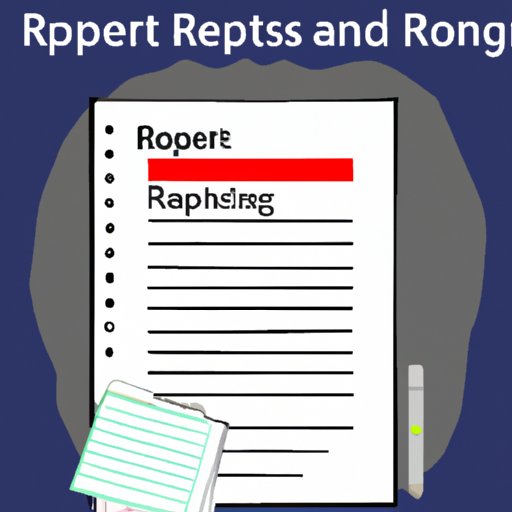Introduction
Report writing is a skill that is used in many different industries and fields of study. From academia to business, reports are used to document findings, analyze data, and present information. It is essential to understand what a report is and how to write one effectively. This article will outline the basics of report writing, explore the different types of reports, provide tips for writing an effective report, and discuss common pitfalls to avoid.

Outlining the Basics of Report Writing
Before getting into the specifics of report writing, it’s important to understand what a report is. A report is an organized written document that presents facts, findings, or other information in a clear and concise manner. Reports are typically structured with sections and headings that make it easy for readers to quickly understand the key points being presented. Reports can be used to inform, persuade, or evaluate.
Common elements of a report include an introduction, body, conclusion, and references. The introduction should provide background information and state the purpose of the report. The body should contain the main content of the report and any relevant data or evidence that supports the argument. The conclusion should summarize the main points and provide recommendations or conclusions. Finally, references should be included to support any claims made in the report.
Structuring a report is also important for making it easy to read and understand. Reports should be organized into sections and subsections with clear headings and subheadings. It is also important to use language that is appropriate for the intended audience and to ensure that all information is accurate and up-to-date.
Exploring the Different Types of Reports
Reports come in many different forms and can be used for a variety of purposes. Common types of reports include academic reports, business reports, technical reports, and investigative reports.
Academic reports are typically used to document research findings or to analyze data gathered from experiments or surveys. They often include an introduction, literature review, methodology, results, discussion, and conclusion. Academic reports are usually written in a formal tone and should use proper grammar and formatting.
Business reports are used to present financial information or to provide analysis of a certain issue. They often include an executive summary, introduction, analysis, and recommendations. Business reports should be written in a clear and concise manner and should use data to support any conclusions.
Technical reports are used to document the results of engineering or scientific tests and experiments. They often include an introduction, methodology, results, discussion, and conclusion. Technical reports should be written in a precise and technical manner and should include all relevant details and data.
Investigative reports are used to document the findings of an investigation. They often include an introduction, background information, analysis, and recommendations. Investigative reports should be written in an objective manner and should include all relevant details and evidence.

Tips for Writing an Effective Report
Writing an effective report requires careful planning and preparation. Here are some tips for writing an effective report:
- Use a clear structure: A well-structured report is easier to read and understand. Use headings and subheadings to organize the information into sections.
- Research thoroughly: Make sure to do thorough research before writing a report. Gather all necessary data and evidence to support your argument.
- Write in an objective manner: Avoid biased language and personal opinions. Stick to the facts and use data to support any claims.
- Proofread and edit: Check for any spelling or grammar errors and make sure the report is formatted correctly.

Common Pitfalls to Avoid When Writing a Report
It is important to be aware of common pitfalls when writing a report. Here are some common pitfalls to avoid:
- Poor organization: A poorly organized report is difficult to read and understand. Make sure to use clear headings and subheadings to organize the information.
- Incorrect facts or data: Make sure to double check all facts and data to ensure accuracy.
- Unclear language: Avoid using jargon and complicated language. Stick to simple language that is easy to understand.
- Not following the proper format: Follow the guidelines for the type of report you are writing. Make sure to use the correct format and style.
Examples of Successful Reports and How They Were Written
To get a better understanding of how to write an effective report, it is helpful to look at successful examples. Here are some examples of successful reports and how they were written:
- Marketing Plan Report: This report was written by a marketing agency to analyze the effectiveness of their client’s marketing plan. It included an introduction, market analysis, competitive analysis, target market segmentation, promotion strategy, and budget. The report was well-structured and used clear headings and subheadings to organize the information.
- Financial Analysis Report: This report was written by a financial analyst to assess the performance of a company’s stock. It included an introduction, financial analysis, risk analysis, and recommendations. The report used clear language and included charts and graphs to illustrate the data.
Conclusion
In conclusion, report writing is an important skill to have in many different fields and industries. It is important to understand the basics of report writing and to familiarize yourself with the different types of reports. Writing an effective report requires careful planning and preparation. Make sure to use a clear structure, research thoroughly, write in an objective manner, and proofread and edit your work. Finally, be aware of common pitfalls to avoid when writing a report.
By following these steps and looking at successful examples, you can write an effective report that will be clear and concise.
(Note: Is this article not meeting your expectations? Do you have knowledge or insights to share? Unlock new opportunities and expand your reach by joining our authors team. Click Registration to join us and share your expertise with our readers.)
